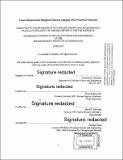| dc.contributor.advisor | Boris Khaykovich. | en_US |
| dc.contributor.author | Delmore, Alexandra R | en_US |
| dc.contributor.other | Massachusetts Institute of Technology. Department of Nuclear Science and Engineering. | en_US |
| dc.date.accessioned | 2019-03-01T19:33:45Z | |
| dc.date.available | 2019-03-01T19:33:45Z | |
| dc.date.copyright | 2017 | en_US |
| dc.date.issued | 2017 | en_US |
| dc.identifier.uri | http://hdl.handle.net/1721.1/120608 | |
| dc.description | Thesis: S.B., Massachusetts Institute of Technology, Department of Nuclear Science and Engineering, 2017. | en_US |
| dc.description | This electronic version was submitted by the student author. The certified thesis is available in the Institute Archives and Special Collections. | en_US |
| dc.description | Cataloged from student-submitted PDF version of thesis. | en_US |
| dc.description | Includes bibliographical references (pages 36-38). | en_US |
| dc.description.abstract | Application and fundamental understanding of magnetic materials requires knowledge of their properties and phase diagrams, which depend on the structure and dynamics of magnetic domains. Current techniques for studying magnetic domains are limited to imaging near-surface magnetic structure. Techniques for investigating bulk magnetic structure are under development, particularly for applications in electronics and superconductivity. This study investigates the feasibility of observing bulk magnetic domain structure using polarized neutron imaging and tomography. Polarized neutrons are advantageous for studying internal magnetic structure because they penetrate materials, and their spin-polarizations are sensitive to magnetic fields. This study experimentally tested the depolarization of neutrons in five different materials with known magnetic order using PONTO, an instrument at Helmholtz-Zentrum Berlin (Germany) that uses a polarization-sensitive filter and analyzer to measure neutron depolarization in magnetic samples. Magnetic structure was observed when samples were subjected to magnetic fields to increase magnetization, and to cooling beneath the Curie temperature. Samples measured at zero field and room temperature randomly depolarized the neutron beam because their domains are smaller than the resolution of PONTO. Successful observation of magnetic effects indicates the promise of polarized neutron imaging for studying bulk magnetic domain structure; however, further development of imaging methods is necessary for understanding the connection between neutron depolarization and domain structure. | en_US |
| dc.description.statementofresponsibility | Alexandra R. Delmore. | en_US |
| dc.format.extent | 38 pages | en_US |
| dc.language.iso | eng | en_US |
| dc.publisher | Massachusetts Institute of Technology | en_US |
| dc.rights | MIT theses are protected by copyright. They may be viewed, downloaded, or printed from this source but further reproduction or distribution in any format is prohibited without written permission. | en_US |
| dc.rights.uri | http://dspace.mit.edu/handle/1721.1/7582 | en_US |
| dc.subject | Nuclear Science and Engineering. | en_US |
| dc.title | Three-dimensional magnetic domain imaging with polarized neutrons | en_US |
| dc.title.alternative | 3-dimensional magnetic domain imaging with polarized neutrons | en_US |
| dc.title.alternative | 3D dimensional magnetic domain imaging with polarized neutrons | en_US |
| dc.type | Thesis | en_US |
| dc.description.degree | S.B. | en_US |
| dc.contributor.department | Massachusetts Institute of Technology. Department of Nuclear Science and Engineering | |
| dc.identifier.oclc | 1088413430 | en_US |
